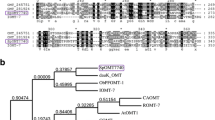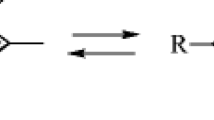Abstract
Biphenyl dioxygenase from Pseudomonas pseudoalcaligenes strain KF707 expressed in Escherichia coli was found to exhibit monooxygenase activity toward four stereoisomers of isoflavan-4-ol. LC–MS and LC–NMR analyses of the metabolites revealed that the corresponding epoxides formed between C2′ and C3′ on the B-ring of each isoflavan-4-ol substrate were the sole products. The relative reactivity of the stereoisomers was found to be in the order: (3S,4S)-cis-isoflavan-4-ol > (3R,4S)-trans-isoflavan-4-ol > (3S,4R)-trans-isoflavan-4-ol > (3R,4R)-cis-isoflavan-4-ol and this likely depended upon the absolute configuration of the 4-OH group on the isoflavanols, as explained by an enzyme–substrate docking study. The epoxides produced from isoflavan-4-ols by P. pseudoalcaligenes strain KF707 were further abiotically transformed into pterocarpan, the molecular structure of which is commonly found as part of plant-protective phytoalexins, such as maackiain from Cicer arietinum and medicarpin from Medicago sativa.






Similar content being viewed by others
References
Boyd DR, Sharma ND (2002) Enzymatic and chemoenzymatic synthesis of arene trans-dihydrodiols. J Mol Catal B: Enzym 19–20:31–42
Carredano E, Karlsson A, Kauppi B, Choudhury D, Parales RE, Parales JV, Lee K, Gibson DT (2000) Substrate binding site of naphthalene 1,2-dioxygenase: functional implications of indole binding. J Mol Biol 296:701–712
Dewick MP, Harborne JB (1994) The flavonoids, advances in research since 1986. Chapman and Hall, London
Engler TA, LaTessa KO, Iyengar R, Chai W, Agrios K (1996) Stereoselectivity syntheses of substituted pterocarpans with anti-HIV activity, and 5-aza-/5-thia-pterocarpan and 2-aryl-2,3-dihydrobenzofuran analogues. Bioorg Med Chem 4:1755–1769
Furukawa K, Hirose J, Hayashida S, Nakamura K (1994) Efficient degradation of trichlorothylene by a hybrid aromatic ring dioxygenase. J Bacteriol 176:2121–2123
Furusawa Y, Nagarajan V, Tanokura M, Masai E, Fukuda M, Senda T (2004) Crystal structure of the terminal oxygenase component of biphenyl dioxygenase derived from Rhodococcus sp. strain RHA1. J Mol Biol 342:1041–1052
Gibson HW (1969) The chemistry of formic acid and its simple derivatives. Chem Rev 69:673–692
Gibson DT, Parales RE (2000) Aromatic hydrocarbon dioxygenases in environmental biotechnology. Curr Opin Biotechnol 11:236–243
Guengerich FP (2003) Cytochrome P450 oxidations in the generation of reactive electrophiles: epoxidation and related reactions. Arch Biochem Biophys 409:59–71
Gursky LJ, Nikodinovic-Runic J, Feenstra KA, O’Connor KE (2010) In vitro evolution of styrene monooxygenase from Pseudomonas putida CA-3 for improved epoxide synthesis. Appl Microbiol Biotechnol 85:995–1004
Han J, Kim S-Y, Jung J, Lim Y, Ahn JH, Kim S-I, Hur HG (2005) Epoxide formation on the aromatic B ring of flavanone by biphenyl dioxygenase of Pseudomonas pseudoalcaligenes KF707. Appl Environ Microbiol 71:5354–5361
Hwang EI, Kaneko M, Ohnishi Y, Horinouchi S (2003) Production of plant-specific flavanones by Escherichia coli containing an artificial gene cluster. Appl Environ Microbiol 69:2699–2706
Karlsson A, Parales JV, Parales RE, Gibson DT, Eklund H, Ramaswamy S (2003) Crystal structure of naphthalene dioxygenase: side-on binding of dioxygen to iron. Science 299:1039–1042
Keenan BG, Leungsakul T, Smets BF, Wood TK (2004) Saturation mutagenesis of Burkholderia cepacia R34 2,4-dinitrotoluene dioxygease at DntAc valine 350 for synthesizing nitrohydroquinone, methylhydroquinone, and methoxyhydroquinone. Appl Environ Microbiol 70:3222–3231
Kim SY, Jung J, Lim Y, Ahn JH, Kim SI, Hur HG (2003) Cis-2′,3′-dihydrodiol production on flavone B-ring by biphenyl dioxygenase from Pseudomonas pseudoalcaligenes KF707 expressed in Escherichia coli. Anton Leeuw Int JG 84:261–268
Kim M, Han J, Kim S-U (2008) Isoflavone daidzein: chemistry and bacterial metabolism. J Appl Biol Chem 51:253–261
Kim M, Won D, Han J (2010) Absolute configuration determination of isoflavan-4-ol stereoisomers. Bioorg Med Chem Lett 20:4337–4341
Kiss L, Kurtán T, Antus S, Bényei A (2003) Chiroptical properties and synthesis of enantiopure cis and trans pterocarpan skeleton. Chirality 15:558–563
Nakagawa M, Nakanishi K, Darko LL, Vick JA (1982) Structures of cabenegrins A-I and A-II, potent anti-snake venoms. Tetrahedron Lett 23:3855–3858
Perrin DR, Cruickshank IAM (1969) The antifungal activity of pterocarpans towards Monilinia fructicola. Phytochem 8:971–978
Selander HG, Jerina DM, Daly JW (1975) Metabolism of chlorobenzene with hepatic microsomes and solubilized cytochrome P450 systems. Arch Biochem Biophys 168:309–321
Seo J, Kang S-I, Kim M, Won D, Takahashi H, Ahn JH, Chong Y, Lee E, Lim Y, Kanaly RA, Han J, Hur HG (2010a) Time-dependent density functional theory-assisted absolute configuration determination of cis-dihydrodiol metabolite produced from isoflavone by biphenyl dioxygenase. Anal Biochem 397:29–36
Seo J, Kang S, Ryu J-Y, Lee Y-J, Park KD, Kim M, Won D, Park H-Y, Ahn JH, Chong Y, Kanaly RA, Han J, Hur HG (2010b) Location of flavone B-ring controls regioselectivity and stereoselectivity of naphthalene dioxygenase from Pseudomonas sp. strain NCIB 9816-4. Appl Microbiol Biotechnol 86:1451–1462
Suenaga H, Watanabe T, Sato M, Ngadiman FK (2002) Alteration of regiospecificity in biphenyl dioxygenase by active-site engineering. J Bacteriol 184:3682–3688
Won D, Shin B-K, Kang S, Hur HG, Kim M, Han J (2008) Absolute configurations of isoflavan-4-ol stereoisomers. Bioorg Med Chem Lett 18:1952–1957
Acknowledgement
This work was supported by the National Research Foundation of Korea (NRF) grant funded by the Korea government (MEST) (No. 2009-0083568).
Author information
Authors and Affiliations
Corresponding authors
Electronic supplementary material
Below is the link to the electronic supplementary material.
ESM 1
(DOC 788 kb)
Rights and permissions
About this article
Cite this article
Seo, J., Kang, SI., Won, D. et al. Absolute configuration-dependent epoxide formation from isoflavan-4-ol stereoisomers by biphenyl dioxygenase of Pseudomonas pseudoalcaligenes strain KF707. Appl Microbiol Biotechnol 89, 1773–1782 (2011). https://doi.org/10.1007/s00253-010-2989-1
Received:
Revised:
Accepted:
Published:
Issue Date:
DOI: https://doi.org/10.1007/s00253-010-2989-1




